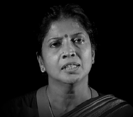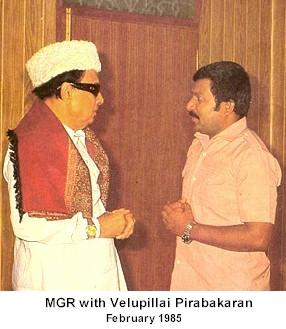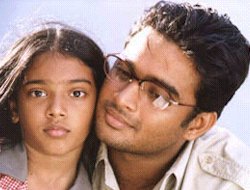|
Kollywood and the Eelam Connection
By
Shanthi Sachithanandam
“ Bid farewell to us, our Land
Our home where the sea laps at the door,
where Palmyrah groves abound providing warm nests for the birds,
will we ever see you again at least once?
We wander as empty skeletons
After burying our smiles into our lips
and burying our souls into our bodies …”
- Scene of refugees fleeing to Tamil Nadu in the film Kannathil Muththamittaal
 This
was back in 2003. As I entered the LTTE office at Puliyankulam in the Vanni to
obtain my ‘visa’ to enter the North, I noticed a
familiar figure in the waiting room. My heart beat a trifle faster at his
sight. He was Nizhalgal Ravi , a famous actor in the South Indian
Tamil film industry who had acted under recognized directors in films such as
Mani Ratnam’s Nayagan and Balu Mahendra’s Marupadiyum.
“I have heard about Mankulam so much. I was determined to see it for myself
and that is the purpose of my visit here..” he was heard
explaining to someone sitting next to him. He was on his pilgrimage to
Mankulam! This
was back in 2003. As I entered the LTTE office at Puliyankulam in the Vanni to
obtain my ‘visa’ to enter the North, I noticed a
familiar figure in the waiting room. My heart beat a trifle faster at his
sight. He was Nizhalgal Ravi , a famous actor in the South Indian
Tamil film industry who had acted under recognized directors in films such as
Mani Ratnam’s Nayagan and Balu Mahendra’s Marupadiyum.
“I have heard about Mankulam so much. I was determined to see it for myself
and that is the purpose of my visit here..” he was heard
explaining to someone sitting next to him. He was on his pilgrimage to
Mankulam!
Sure enough, the heroic battles waged by the LTTE in the defense of Mankulam
town during Jayasikurui operations had fired the imagination
of the film world in Chennai. But that could not be the only reason why
Kodampakkam filmdom (popularly known as Kollywood), that is now
being rated to be at par with the commercialization and technological
development of the international film industry, had got starry eyed
about the affairs of the Sri Lankan Tamils. It is a highly professional outfit
dictated to by the market, and the market only. There had to be
a more solid reason than the idealism of a national liberation struggle.
 Perhaps market was the reason that Tamil films hardly referred to the
existence of Sri Lankan Tamils during the pre 1980s. After all, we
were a mere 3 million compared to their 80 million. In the films of
yesteryears, occasionally a character might run away to ‘Ceylon’, that was
all one heard about in reference to this country. Although the influx of
thousands of refugees from Sri Lanka in the 1980s forced the Tamils
in Tamil Nadu to take notice of this group called Sri Lankan Tamils, it did
not significantly alter the existing status quo of the Sri Lankan
Tamils. As far as their cinema was concerned, this had not made any impact.
Yes, evergreen hero and the then Chief Minister
M.G.Ramachandran was known to hold a candle for Prabakaran; some music
directors and singers did work on music albums produced for
the various SL Tamil militant groups; being an ardent supporter of the Eelam
cause, hero actor Vijayakanth did produce and act in a film titled
“Captain Prabakaran” ( which story incidentally was not even remotely
connected to the real struggle taking place here). But, leaving these
peripheral factors aside, Kollywood made no attempts to depict nor take the
message of Sri Lankan Tamils to their audience. Perhaps market was the reason that Tamil films hardly referred to the
existence of Sri Lankan Tamils during the pre 1980s. After all, we
were a mere 3 million compared to their 80 million. In the films of
yesteryears, occasionally a character might run away to ‘Ceylon’, that was
all one heard about in reference to this country. Although the influx of
thousands of refugees from Sri Lanka in the 1980s forced the Tamils
in Tamil Nadu to take notice of this group called Sri Lankan Tamils, it did
not significantly alter the existing status quo of the Sri Lankan
Tamils. As far as their cinema was concerned, this had not made any impact.
Yes, evergreen hero and the then Chief Minister
M.G.Ramachandran was known to hold a candle for Prabakaran; some music
directors and singers did work on music albums produced for
the various SL Tamil militant groups; being an ardent supporter of the Eelam
cause, hero actor Vijayakanth did produce and act in a film titled
“Captain Prabakaran” ( which story incidentally was not even remotely
connected to the real struggle taking place here). But, leaving these
peripheral factors aside, Kollywood made no attempts to depict nor take the
message of Sri Lankan Tamils to their audience.
The large scale emigration of Sri Lankan Tamils to western Europe, North
America and Australia began to change this equation. The
economic opportunities that opened to the new immigrants in these countries
helped develop their entrepreneur skills. Ever enthusiastic in
nurturing and developing their language and cultural traditions, it were the
Sri Lankan Tamils who initiated the 24 hour Tamil radio and
television transmissions in these countries. Tamil language magazines abounded
and Hindu temples sprouted practically everywhere. It is
remarkable that despite the presence of larger numbers of South Indian Tamils,
these initiatives had to come from the Sri Lankans who were
late arrivals and that too as asylum seekers. Anyway, inevitably all the
mentioned ventures needed fund raising events and also various
celebrations, for which South Indian Stars were invited. This is where the new
found economic power of the Sri Lankan Tamils began to be
felt by Kollywood.
Beginning around the 1990s, the most popular stars of the South Indian cinema
were invited to North America and western Europe for
musical and dance shows. These shows provided considerable incomes to the
actors and actresses outside of their usual film commitments,
which were rather seasonal. Not restricting themselves to merely hiring stars
for shows, the diaspora Tamil community began to dabble in
film production. In 1988 a Sri Lankan Tamil living in UK financed director
Balu Mahendra’s film “Veedu” (meaning house), which was acclaimed
and went on to win national awards in India. This financier was the former
member of the Thamil Maanavar Peravai (Tamil Students Forum) in
Jaffna, and one of the suspects arrested in 1974 in connection with the early
acts of sabotage there and subsequently released. “Veedu” is
significant as probably the first film that brought out the dilemmas of the
growing educated middle class of South India through depicting the
struggle of a working couple trying to acquire land and build a house in
Chennai. Thus opened the possibility of Sri Lankans investing in
Kollywood films.
 Films identified as having Sri Lankan investors started appearing around the
1990s. Some of them were specifically marked as sponsored by the
LTTE. “Kattrukkenna Veli” (meaning can the wind be fenced in) was one such
film which traces the experiences of a female tiger cadre taken
across to Tamil Nadu for medical treatment after a major Army camp attack.
Director Seeman’s “Thambi” (meaning younger brother) released
in 2005, was also rumoured as having been financed by LTTE’s television
channel. There was a strong basis for this suspicion , as the title
name is what Prabakaran was popularly known amongst his peers in the 1970s and
1980s due to him being the youngest of them all. Also,
this film script was based on the argument that only violence produces social
change. The hero, significantly named as Velu Thondaimaan, is
supposed to be a revolutionary characterized as possessing infinite love along
with immense anger intolerant of injustice. The popular heart
throb Madhavan and the part Sri Lankan heroine Pooja acted in this film which
ran 150 days full house. Seeman was interviewed in the
magazine ‘Anantha Vikaten’, a weekly sold over a million copies in Tamil Nadu.
“I dedicate this film to both Periyaar (the great Tamil
intellectual E.V. Ramasamy) and Prabakaran..” he declared. Films identified as having Sri Lankan investors started appearing around the
1990s. Some of them were specifically marked as sponsored by the
LTTE. “Kattrukkenna Veli” (meaning can the wind be fenced in) was one such
film which traces the experiences of a female tiger cadre taken
across to Tamil Nadu for medical treatment after a major Army camp attack.
Director Seeman’s “Thambi” (meaning younger brother) released
in 2005, was also rumoured as having been financed by LTTE’s television
channel. There was a strong basis for this suspicion , as the title
name is what Prabakaran was popularly known amongst his peers in the 1970s and
1980s due to him being the youngest of them all. Also,
this film script was based on the argument that only violence produces social
change. The hero, significantly named as Velu Thondaimaan, is
supposed to be a revolutionary characterized as possessing infinite love along
with immense anger intolerant of injustice. The popular heart
throb Madhavan and the part Sri Lankan heroine Pooja acted in this film which
ran 150 days full house. Seeman was interviewed in the
magazine ‘Anantha Vikaten’, a weekly sold over a million copies in Tamil Nadu.
“I dedicate this film to both Periyaar (the great Tamil
intellectual E.V. Ramasamy) and Prabakaran..” he declared.
Whatever these may be, the diaspora community made more impact as viewers and
fans rather than as investors of films. Tamil films began
to be heavily dependant on the market in the developed countries especially
amongst the Sri Lankan Tamils. It is claimed that top actor
Kamalhasan earns his income for acting in films by buying the rights to
distribution in these countries. Nowadays Tamil films run in the main
film circuits in the UK in London as well as other cities such as Birmingham.
Recently, actor Vijay’s (rated as the future super star) film
“Pokkiri” (meaning Rascal) ran to box office records in UK prompting the star
to publicly thank his Sri Lankan fans. Mani Ratnam had the
premiere of his film “Guru” starring Aishwarya Rai and Abishek Bachchan, not
in any cities of India, but in Torronto!
Thangar Bachchan, a director of serious films and a prominent member of the
Film Actors Guild burst out at other big stars in an interview to
Ananda Vikaten. “ You invest 20 and 30 crores in your films, trusting whom?
Isn’t it on the market created by the Eelam Tamils living all over
the world? (If they contribute so much to your coffers) then is it not proper
that you share in their grief as well?…..He (the Sri Lankan) has
lost his land and has been humiliated. Each of you go and perform in cultural
shows and grab his money earned through melting his life, isn’t
it” He was castigating all the top actors for their inadequate vocal support
extended to the cause of theTamil liberation struggle.
 Even though these actors and directors as Thangar Bachchan claims have not
climbed up on political stages to vocalize their support, they
have brought out some powerful films on the Eelam struggle and the situation
of the immigrants. The classical director Bala did “Nanda”, shot
in Rameswaram about a local overlord getting entangled in the politics of the
boat refugees from Sri Lanka. This film is undoubtedly one of
the greatest to emerge from Kollywood. Mani Ratnam made “Kannathil
Muththamittaal” (meaning if your cheeks are kissed) about an adopted
nine year old girl from Chennai going in search of her biological mother who
is a LTTE cadre in the Vanni. Kamalhassan produced and acted
in “Thenali” a serious comedy where the hero is a young Sri Lankan living in
Tamil Nadu traumatized by his experiences during the war.
Kamalhassan made another film “Nala Damayanthi” where the heroine is a Sri
Lankan single woman living in Australia. Another recent release
is “Cyanide”, originally made in Kannada about one of the accomplices in the
Rajiv Gandhi murder, Sivarasan. This has become a runaway
success in Karnataka and is now dubbed and released in Tamil Nadu. Cyanide’s
director Suresh was asked as to why he shone Sivarasan as
a hero in that film. He had explained that even though killing Rajiv Gandhi
was unacceptable, the struggle waged by the Tamils in their
homeland had to be given due respect. Even though these actors and directors as Thangar Bachchan claims have not
climbed up on political stages to vocalize their support, they
have brought out some powerful films on the Eelam struggle and the situation
of the immigrants. The classical director Bala did “Nanda”, shot
in Rameswaram about a local overlord getting entangled in the politics of the
boat refugees from Sri Lanka. This film is undoubtedly one of
the greatest to emerge from Kollywood. Mani Ratnam made “Kannathil
Muththamittaal” (meaning if your cheeks are kissed) about an adopted
nine year old girl from Chennai going in search of her biological mother who
is a LTTE cadre in the Vanni. Kamalhassan produced and acted
in “Thenali” a serious comedy where the hero is a young Sri Lankan living in
Tamil Nadu traumatized by his experiences during the war.
Kamalhassan made another film “Nala Damayanthi” where the heroine is a Sri
Lankan single woman living in Australia. Another recent release
is “Cyanide”, originally made in Kannada about one of the accomplices in the
Rajiv Gandhi murder, Sivarasan. This has become a runaway
success in Karnataka and is now dubbed and released in Tamil Nadu. Cyanide’s
director Suresh was asked as to why he shone Sivarasan as
a hero in that film. He had explained that even though killing Rajiv Gandhi
was unacceptable, the struggle waged by the Tamils in their
homeland had to be given due respect.
Apart from films made in India on the Eelam struggle, attempts have been made
also to produce them in the authentic setting of the Vanni. Art
director Mahendran’s son John was invited by one Mr. Prabakaran (not the LTTE
leader) who heads the Tamil Living Media Network in
Switzerland, to make a film in the Vanni. Accordingly “Aaniver” (meaning tap
root) was filmed in the Vanni under LTTE’s supervision. The
director admitted that leader Prabakaran advised extensively on the storyline
, desiring it to deal exclusively with the plight of the war affected
Vanni Tamils. This film has now been nominated for the International film
festival to be held in Hyderabad in April 2007 purely on the
initiatives of the jury. During the period of making this film, Mahendran also
traveled to the Vanni to conduct film production classes for artistes
there. Joining this line of film directors, Bharathiraja has vowed to make a
film on the Eelam struggle, after his travels to the Vanni around the
same time. “When I met leader Prabakaran, I developed goose pimples..” he was
later to recount his experiences in an interview.
Not only directors, but song writers too jumped on to the political platform
of Eelam. After the year 2000 many love songs have been
composed where references are made to the Eelam war. “ When the Eelam war
ceases, I want to decorate your hair with the flowers
blooming from its soil..” says one lover. “Let all noises cease including the
sounds of war from Eelam so I can hear only the noise of your
breath..” says another. In another film where the hero and heroine come from
different social classes, she poses a series of questions to her
lover in a song. “What if you are America and I am Afghanistan, where can we
hold our wedding?” is one such question. The hero answers all
the questions except when she asks “what if you are Sri Lanka and I am
LTTE..?” To this question he can only howl “Aiyo, please shut your
mouth..” All these songs have been mega hits.
The Tamil cinema has changed very much in many ways except one. That is the
sway it has over Tamil Nadu politics. Being an actor sought
by the market also means that one has the possibility to become the chief
Minister of the State. M.G. Ramachandran, a Malayali by birth, was
never defeated till he died. Even Karunanidhi had to maintain his links with
the cinema world in order to strengthen his political fortunes. Super
star Rajinikanth, a Kannadiga, was persuaded time and again by his fans to
contest elections in Tamil Nadu. Vijayakanth is another up and
coming political personality. Actually, at present, the situation is that
almost all the stars who are professionally on the wane have jumped into
political work. Apart from creating political leaders, the Tamil cinema has
also played on the caste politics in Tamil Nadu. Sometimes the
theatres where new films of popular actors are released become the arena where
these caste conflicts are fought out. The urban under class
doubles up as fans as well as the mass base of these parties.
I was traveling in an auto in Chennai. As is usual to Chennai traffic the ride
was hazardous, prompting me to let out screams of fear. “What
Amma, you people are fighting the Sri Lanka Army so heroically in your country
and you are scared of such small things here..?” the auto
driver asked me to my utter surprise! He, is that participant in the
demonstrations that the Tamil Nadu political parties organize in support of
Eelam cause, and also, the politicized voter. In both roles he can exert
significant influence on his government which in turn would do the
same on the government in New Delhi. Unless we are aware of the moods
displayed by Tamil Nadu, we will never be able to fathom the
moves of New Delhi. Those wandering skeletons which left our shores in search
of new homes in the West, after having buried their smiles in
their lips and their souls in their bodies, might determine our politics,
after all.
Courtesy: http://www.viluthu.org/Articles.html |

